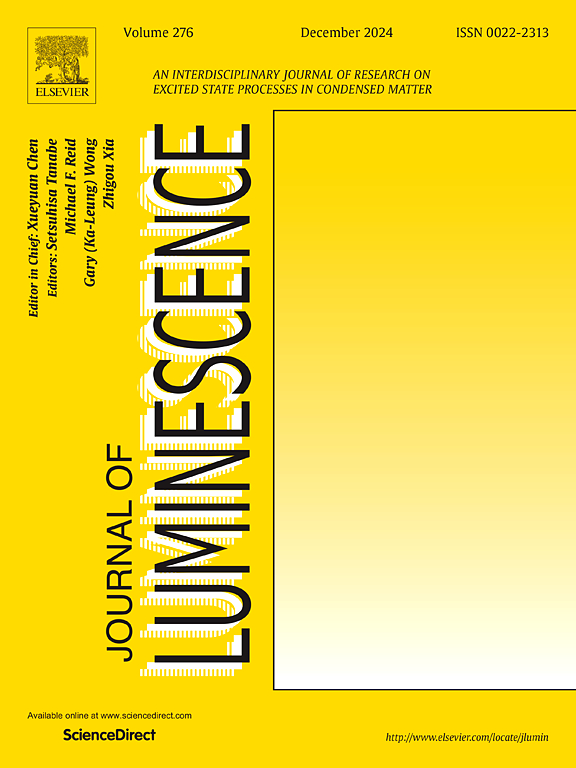Temperature-induced localized exciton dynamics in inorganic CsPbX3 (X=I, Br, Cl) perovskite nanocrystals
IF 3.3
3区 物理与天体物理
Q2 OPTICS
引用次数: 0
Abstract
The exceptional luminescent properties of inorganic halide perovskites have recently garnered significant attention. This study comprehensively investigates the temperature dependence of the anomalous behavior of localized excitons in inorganic CsPbX3 (X = I, Br, and Cl) perovskite nanocrystals (NCs). A quantitative model has been developed to determine the photoluminescence (PL) peak energy and PL linewidth through a broad temperature range (from 10 K to 300 K) using Monte Carlo simulation of exciton relaxation and hopping processes. Incorporating temperature-induced bandgap expansion allows for a quantitative fit of our computational model to the experimental findings. The PL peak energies of all CsPbX3 NCs exhibit a blue shift due to the localization of excitons in higher energy states at elevated temperatures. On moving from X = I to Br to Cl, the rate of bandgap expansion decreases with temperature, which indicates that the ionic bond between cation and anion becomes stronger, resulting in less shifting in PL peak energy. The PL linewidth is significantly influenced by thermal disorder, resulting in a noticeable increase in the full-width half maximum (FWHM) as the temperature rises. Additionally, it has been observed that excitons in deeper localized states are minimal in CsPbBr3 and CsPbCl3. This study is important in understanding and optimizing the performance, tuning the emission characteristics, and improving the reliability of cesium halide perovskite-based devices.
无机CsPbX3 (X=I, Br, Cl)钙钛矿纳米晶体中温度诱导的局域激子动力学
无机卤化物钙钛矿的特殊发光特性最近引起了人们的极大关注。本研究全面研究了无机CsPbX3 (X = I, Br和Cl)钙钛矿纳米晶体(NCs)中局域激子异常行为的温度依赖性。利用激子弛豫和跳变过程的蒙特卡罗模拟,建立了一个定量模型,以确定在宽温度范围内(从10 K到300 K)的光致发光(PL)峰值能量和PL线宽。结合温度引起的带隙扩展允许我们的计算模型与实验结果的定量拟合。由于激子在高温下处于高能态,所有CsPbX3 NCs的PL峰值能量都表现出蓝移。从X = I到Br再到Cl,带隙扩展速率随温度的升高而减小,说明正离子与阴离子之间的离子键变得更强,导致PL峰值能量的位移减小。PL线宽受热失序的影响显著,随着温度的升高,全宽半最大值(FWHM)显著增加。此外,已经观察到CsPbBr3和CsPbCl3中处于更深局域态的激子最少。该研究对于理解和优化卤化铯钙钛矿基器件的性能、调整发射特性以及提高器件的可靠性具有重要意义。
本文章由计算机程序翻译,如有差异,请以英文原文为准。
求助全文
约1分钟内获得全文
求助全文
来源期刊

Journal of Luminescence
物理-光学
CiteScore
6.70
自引率
13.90%
发文量
850
审稿时长
3.8 months
期刊介绍:
The purpose of the Journal of Luminescence is to provide a means of communication between scientists in different disciplines who share a common interest in the electronic excited states of molecular, ionic and covalent systems, whether crystalline, amorphous, or liquid.
We invite original papers and reviews on such subjects as: exciton and polariton dynamics, dynamics of localized excited states, energy and charge transport in ordered and disordered systems, radiative and non-radiative recombination, relaxation processes, vibronic interactions in electronic excited states, photochemistry in condensed systems, excited state resonance, double resonance, spin dynamics, selective excitation spectroscopy, hole burning, coherent processes in excited states, (e.g. coherent optical transients, photon echoes, transient gratings), multiphoton processes, optical bistability, photochromism, and new techniques for the study of excited states. This list is not intended to be exhaustive. Papers in the traditional areas of optical spectroscopy (absorption, MCD, luminescence, Raman scattering) are welcome. Papers on applications (phosphors, scintillators, electro- and cathodo-luminescence, radiography, bioimaging, solar energy, energy conversion, etc.) are also welcome if they present results of scientific, rather than only technological interest. However, papers containing purely theoretical results, not related to phenomena in the excited states, as well as papers using luminescence spectroscopy to perform routine analytical chemistry or biochemistry procedures, are outside the scope of the journal. Some exceptions will be possible at the discretion of the editors.
 求助内容:
求助内容: 应助结果提醒方式:
应助结果提醒方式:


